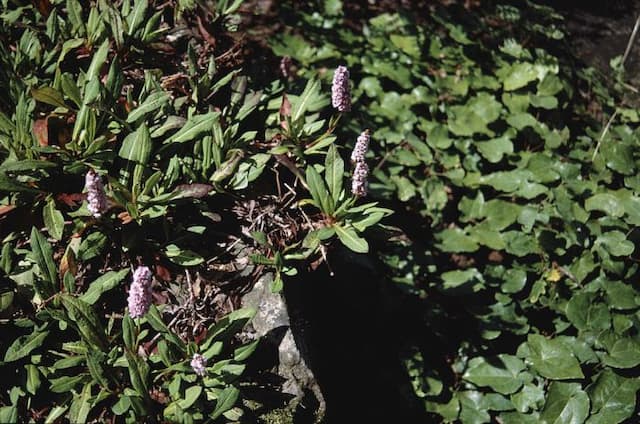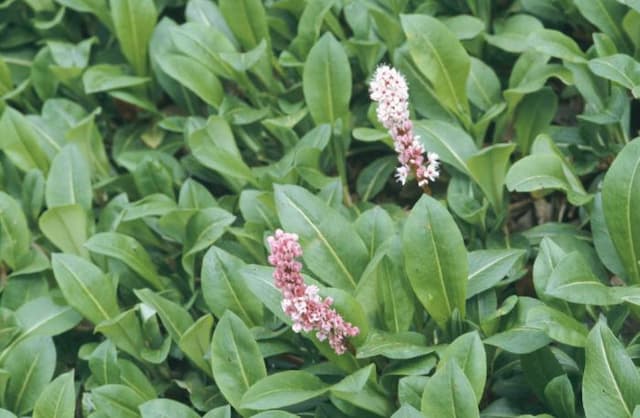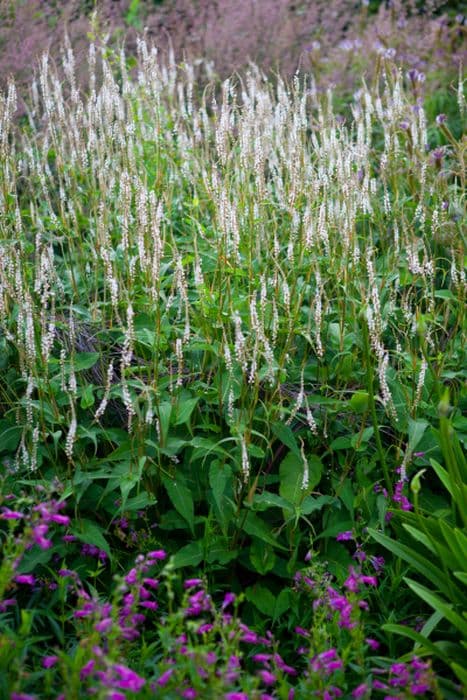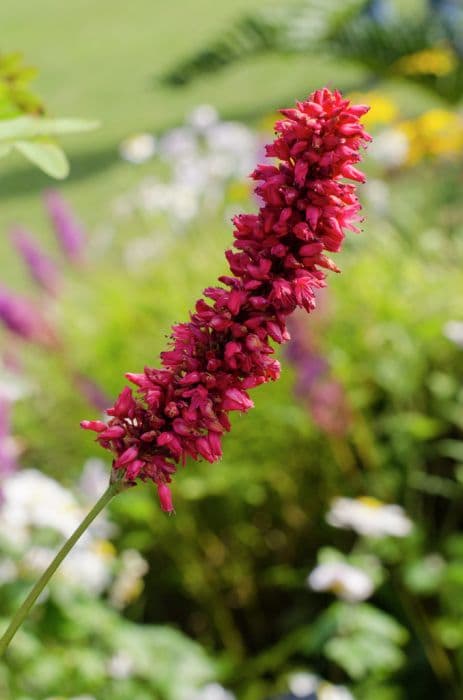Red Bistort Persicaria amplexicaulis 'October Pink'
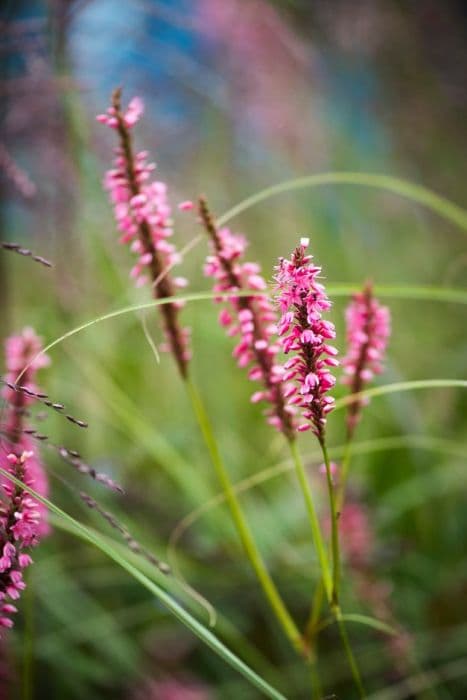
ABOUT
The Persicaria amplexicaulis 'October Pink', commonly referred to as the 'Mountain Fleece', showcases distinct features that adorn gardens with its aesthetic appeal. The most striking aspect of this plant is its profusion of elongated, slender spikes that boast delicate tiny pink flowers. These flower spikes bloom profusely, creating a haze of soft pink that adds a touch of romance to the garden landscape. The blooms have a fluffy appearance, drawing pollinators and admirers alike. The foliage of the Mountain Fleece is equally attractive, comprising large, broad leaves that cling close to the stems. Their lush green color provides a perfect backdrop for the vibrant pink flowers and adds a robust and full-bodied presence in the garden. Typically, the leaves have a slightly glossy finish and a pointed, heart-shaped base that clasps the stem, fitting the 'amplexicaulis' part of its name, which means 'clasping the stem.' The overall shape of the plant is bushy, forming clumps that spread outwards with abundant growth. This habit makes it an excellent choice for filling in gaps in borders or adding structure to planting schemes. Its enduring display from mid-summer to fall grants it a prolonged period of visual interest in the outdoor space. Mountain Fleece is also noted for its undemanding nature and its ability to thrive in a range of different soil types, providing they are moist. Its resilience and the easy-going nature make it a favored choice for gardeners seeking both beauty and reliability.
About this plant
 Names
NamesFamily
Polygonaceae.
Synonyms
Mountain Fleece, Red Bistort, Bistort, False Bistort.
Common names
Persicaria amplexicaulis 'October Pink'.
 Toxicity
ToxicityTo humans
The Persicaria amplexicaulis, commonly known as red bistort or mountain fleece, is not generally considered toxic to humans. However, as with many plants, it is always wise to be cautious and avoid ingestion unless it is known to be safe. There is no significant evidence of the plant causing poisoning in humans, therefore symptoms of poisoning are not well-documented.
To pets
The red bistort or mountain fleece is not widely documented as toxic to pets such as dogs and cats. There is limited information on the plant's toxicity levels, and it appears to be generally safe around animals. Pets should not be allowed to ingest plants indiscriminately, but there are no specific symptoms of poisoning commonly associated with this plant in pets. It is always best to monitor your pets and keep them from eating any plants to avoid any potential health issues.
 Characteristics
CharacteristicsLife cycle
Perennials
Foliage type
Deciduous
Color of leaves
Green
Flower color
Pink
Height
3-4 feet (0.91-1.22 meters)
Spread
2-3 feet (0.61-0.91 meters)
Plant type
Herb
Hardiness zones
4-7
Native area
Himalayas
Benefits
 General Benefits
General Benefits- Attracts pollinators: Provides food for bees, butterflies, and other beneficial insects, helping to support local ecosystems.
- Low maintenance: Requires minimal care once established, making it ideal for gardeners of all levels.
- Long blooming period: Flowers from midsummer to autumn, offering extended visual interest in the garden.
- Resistant to pests and diseases: Naturally resistant to many common pests and diseases, reducing the need for chemical treatments.
- Drought tolerant: Once established, it can withstand periods of low rainfall, making it suitable for drier climates.
- Versatile planting options: Can be used in mixed borders, cottage gardens, or as a standalone specimen, offering flexibility in garden design.
- Enhances garden aesthetics: Adds vibrant pink color and texture to the garden with its tall, slender spikes of flowers.
- Improves soil stability: Helps to prevent soil erosion with its dense root system, particularly useful on slopes or in areas prone to erosion.
 Medical Properties
Medical PropertiesThis plant is not used for medical purposes.
 Air-purifying Qualities
Air-purifying QualitiesThis plant is not specifically known for air purifying qualities.
 Other Uses
Other Uses- Persicaria amplexicaulis 'October Pink' can be used in natural dyeing processes, as some species of Persicaria are known to produce colors that can dye fabrics.
- The dried flowers can be incorporated into potpourri mixes for a touch of color and a subtle, earthy fragrance in the home.
- Insects such as bees and butterflies are attracted to the flowers, so they can be used to support local pollinator populations in a garden.
- The plant could serve as a study subject for botany students or enthusiasts looking to learn more about the Polygonaceae family's characteristics and growth patterns.
- Persicaria amplexicaulis 'October Pink' can be planted alongside water bodies to help stabilize the soil and prevent erosion due to its robust root system.
- The plant may be used in art projects, such as pressing the leaves or flowers for botanical prints or inclusion in nature-themed crafts.
- The long blooming period makes it an ideal candidate for ornamental displays in public spaces such as parks and gardens to provide prolonged visual interest.
- Used as a natural food source for wildlife; the seeds can be consumed by birds in the late season, providing them with necessary nutrients during times of scarcity.
- The striking pink color of the flowers can be used as part of color-themed garden designs, like "pink gardens," to create a specific aesthetic.
- Gardening enthusiasts might employ the plant in permaculture designs as it is a hardy perennial that can thrive with minimal intervention once established.
Interesting Facts
 Feng Shui
Feng ShuiThe plant Persicaria is not used in Feng Shui practice.
 Zodiac Sign Compitability
Zodiac Sign CompitabilityThe plant Persicaria is not used in astrology practice.
 Plant Symbolism
Plant Symbolism- Resilience: Persicaria amplexicaulis, commonly known as the "Red Bistort," often symbolizes resilience as it is a hardy plant able to withstand various challenging conditions.
- Persistence: The Red Bistort’s ability to bloom until late in the season is seen as a symbol of persistence, thriving despite the onset of colder temperatures.
- Vibrant Energy: With its bright 'October Pink' flowers, the Red Bistort is often associated with vibrant energy and liveliness, bringing a pop of color to the garden when many other plants have ceased blooming.
- Adaptability: This plant's versatility in various garden settings represents adaptability, as it can flourish in a range of soil types and light conditions.
 Water
WaterThe red bistort or mountain fleece 'October Pink' thrives when the soil is kept consistently moist, especially in the warmer months. Water the plant deeply once a week, providing about 1 to 1.5 gallons of water to ensure the soil is thoroughly saturated. However, during hot, dry spells, watering frequency may need to increase to twice a week. Reduce watering in the fall and winter when the plant is not actively growing. Always check the top inch of the soil before watering; if it feels dry, it's time to water the plant.
 Light
LightRed bistort 'October Pink' prefers full sun to partial shade conditions. An ideal spot would be one that receives morning sunlight and some afternoon shade, especially in hot climates to prevent leaf scorch. However, it is adaptable and can also flourish in a location that offers dappled sunlight throughout the day.
 Temperature
TemperatureRed bistort 'October Pink' is hardy and can tolerate temperatures as low as 0°F, making it suitable for growth in many climates. The ideal temperature range for this plant is between 60°F to 75°F. While it can withstand occasional heat spikes, prolonged exposure to temperatures above 85°F may stress the plant.
 Pruning
PruningPruning red bistort 'October Pink' is essential to maintain a tidy appearance and promote vigorous growth. Deadhead spent flower spikes throughout the blooming season to encourage additional blooms. In late fall or early spring, cut back the entire plant to a few inches above the ground to rejuvenate and stimulate new growth. Every few years, consider division in spring to keep the clumps manageable.
 Cleaning
CleaningAs needed
 Soil
SoilFor Red Bistort 'October Pink', a soil mix with good drainage is essential. A combination of garden soil, compost, and a small amount of sand or perlite would work well to keep the roots healthy. This plant prefers a soil pH ranging from 5.5 to 7.0.
 Repotting
RepottingRed Bistort 'October Pink' doesn't require frequent repotting as it is a hardy perennial. Repotting can be done every 2-3 years to refresh the soil or if the plant has outgrown its current container.
 Humidity & Misting
Humidity & MistingRed Bistort 'October Pink' is not particularly humidity sensitive and can tolerate a wide range of humidity levels, but it performs best with average to high humidity conditions, similar to what it would experience in its natural outdoor environment.
 Suitable locations
Suitable locationsIndoor
Ensure bright indirect light and keep the soil moist for indoor Red Bistort.
Outdoor
Choose a sunny or part-shade area and water regularly for outdoor Red Bistort.
Hardiness zone
4-7 USDA
 Life cycle
Life cyclePersicaria amplexicaulis 'October Pink', also known as Mountain Fleece 'October Pink', begins its growth cycle in early spring as temperatures rise and the ground thaws. New shoots emerge from the plant's rhizomatous root system, developing into lush, bushy foliage. During late spring to early summer, leafy flowering stems elongate, and by mid to late summer, slender, spike-like pink flowers start to appear. These flowers, attractive to pollinators such as bees and butterflies, continue blooming into the fall, usually peaking in October, hence the cultivar name 'October Pink'. Once the flowering season concludes and temperatures drop, the plant's aerial parts die back to the ground, entering a period of winter dormancy. In this dormant stage, the plant conserves energy within its roots, surviving until the cycle recommences with the following spring's warmth.
 Propogation
PropogationPropogation time
Summer to Fall
Persicaria amplexicaulis 'October Pink', commonly known as Red Bistort or Mountain Fleece, is best propagated through division. The ideal time for propagating this hardy perennial is in the spring, after the threat of frost has passed. To propagate by division, first, dig up the plant carefully to minimize root damage. Then, using a sharp spade or knife, divide the root clump into smaller sections, each with a portion of the root system and several shoots. Replant the divisions at the same depth they were originally growing, spacing them about 15 to 18 inches (approximately 38 to 46 cm) apart to allow for growth. Water the new plantings thoroughly to help them establish. This method is straightforward and usually results in a good success rate, with the divisions quickly growing into robust plants.
![Red bistort [JS Seven Oaks Village]](/_next/image?url=https%3A%2F%2Fplants-admin.emdemapps.com%2Fimages%2Fplants%2F%2Fimages%2F604b56557c0e3.png&w=640&q=75)




